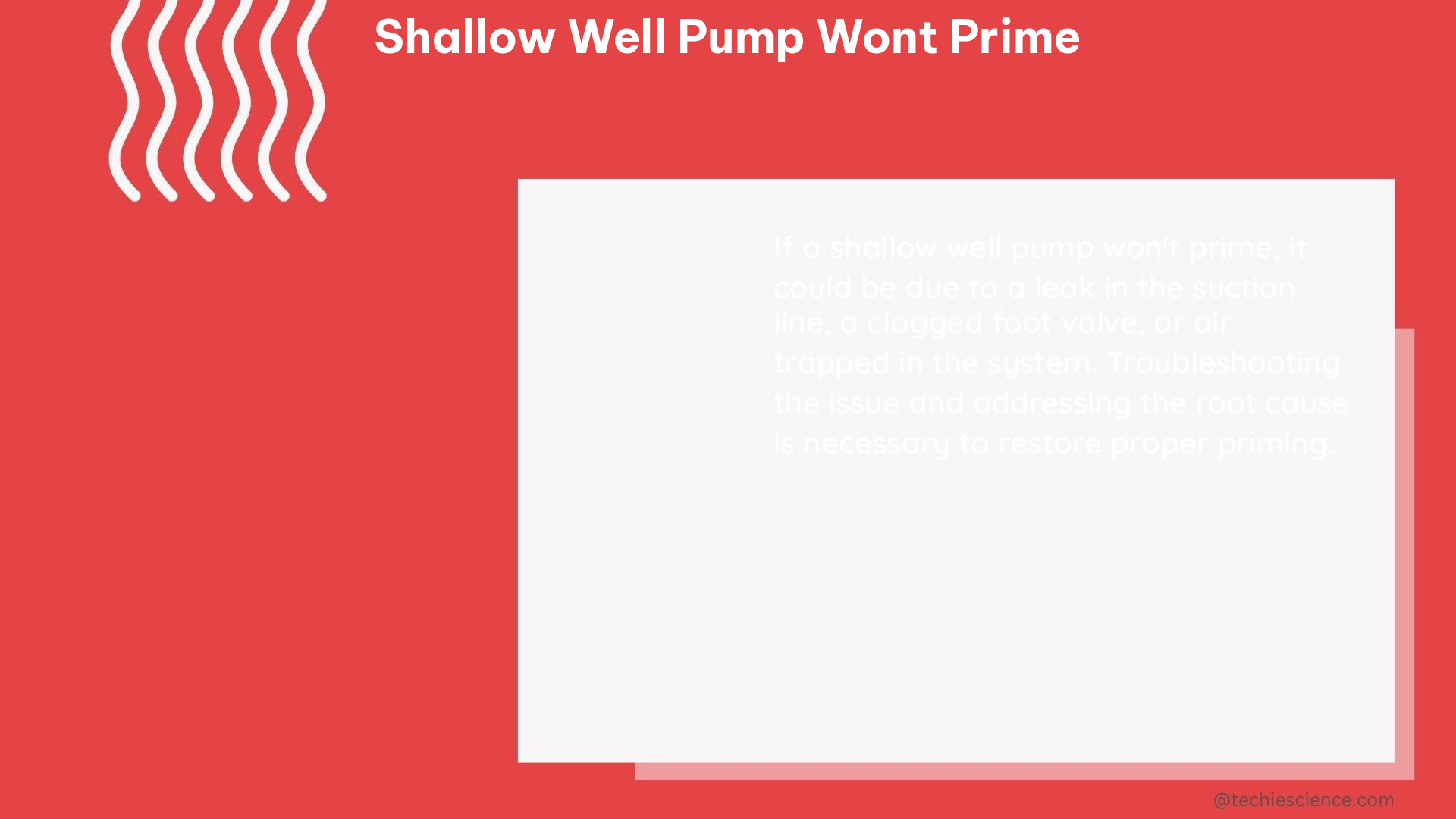Shallow well pumps are essential for drawing water from wells that are not very deep, typically up to 25 feet. However, these pumps can sometimes fail to prime, causing a lot of inconvenience. In this comprehensive guide, we will provide a detailed analysis of the problem, technical specifications of shallow well pumps, and a step-by-step DIY guide to address the issue of a shallow well pump that won’t prime.
Measurable and Quantifiable Data on Shallow Well Pump Won’t Prime
- A shallow well jet pump should prime within 30 seconds to 1 minute after starting.
- If a shallow well jet pump takes longer than 5 minutes to prime, it’s likely that there is a leak in the system or the foot valve is not working correctly.
- A new 1/2 HP jet pump and 44-gallon pressure tank should be able to handle a water source that is 20 feet out and 10-12 feet down a slope.
- A foot valve should be checked for debris, such as grass or twigs, that can clog the screen and prevent the pump from priming correctly.
- A suction leak is the most common cause of a jet pump that can’t prime, except for a stuck or leaking check valve.
- A shallow well jet pump should be able to handle air well and evacuate air from the suction line.
- A Goulds J05N jet pump, which is a shallow well jet pump, can handle a well that is 20-25 feet deep.
Technical Specifications of Shallow Well Pump

A shallow well jet pump is a type of pump that is designed to lift water from shallow wells, typically up to 25 feet deep. The pump consists of a motor, a centrifugal pump, and a jet assembly. The motor drives the centrifugal pump, which creates a vacuum that draws water through the suction line. The jet assembly, which is located in the well, directs a high-velocity jet of water into the suction line, creating a low-pressure area that draws more water into the suction line. The water is then discharged through the discharge line into a pressure tank, which stores the water under pressure.
The technical specifications of a shallow well jet pump include:
| Specification | Range |
|---|---|
| Horsepower | 1/2 HP to 2 HP |
| Voltage | 115V or 230V AC |
| Flow Rate | Up to 10 GPM at 25 feet depth (for 1/2 HP pump) |
| Suction Lift | Up to 25 feet (for 1/2 HP pump) |
| Discharge Pressure | Up to 50 PSI (for 1/2 HP pump) |
DIY Guide to Address Shallow Well Pump Won’t Prime
If your shallow well pump won’t prime, here are the steps you can take to diagnose and fix the problem:
1. Check for Leaks
The first thing you should do is check for leaks in the system. A leak in the suction line or the pressure tank can prevent the pump from priming. Look for wet spots or water stains around the pump, the pressure tank, and the suction line. You can use a water leak detector or a simple visual inspection to identify any leaks.
2. Check the Foot Valve
The foot valve is located at the bottom of the suction line and is designed to prevent water from flowing back into the well. If the foot valve is clogged or damaged, it can prevent the pump from priming. To check the foot valve, disconnect the suction line from the pump and lower it into the well. If the foot valve is clogged, you can try cleaning it with a brush or replacing it.
3. Check the Check Valve
The check valve is located in the discharge line and is designed to prevent water from flowing back into the pump. If the check valve is stuck or leaking, it can prevent the pump from priming. To check the check valve, disconnect the discharge line from the pressure tank and check for leaks. If the check valve is stuck, you can try freeing it with a screwdriver or replacing it.
4. Prime the Pump
If there are no leaks and the foot valve and check valve are working correctly, you can try priming the pump. To prime the pump, fill the suction line with water and then start the pump. The pump should draw water from the well into the suction line and discharge it into the pressure tank.
5. Check the Air Volume
If the pump still won’t prime, there may be too much air in the system. To check the air volume, disconnect the discharge line from the pressure tank and open the valve. The pump should draw water from the well into the discharge line and expel the air. If the pump is still unable to prime, you may need to check for other issues, such as a damaged impeller or a clogged jet assembly.
By following these steps, you should be able to diagnose and fix the issue of a shallow well pump that won’t prime. Remember to always prioritize safety and consult a professional if you are unsure about any aspect of the repair process.
References
- Shallow Well Jet Pump Won’t Prime or Pressurize
- Jet Pump Can’t Prime
- New Shallow Well Jet Pump Won’t Prime
- Priming a Water Pump Problems
- How to Prime a Shallow Well Jet Pump

The lambdageeks.com Core SME Team is a group of experienced subject matter experts from diverse scientific and technical fields including Physics, Chemistry, Technology,Electronics & Electrical Engineering, Automotive, Mechanical Engineering. Our team collaborates to create high-quality, well-researched articles on a wide range of science and technology topics for the lambdageeks.com website.
All Our Senior SME are having more than 7 Years of experience in the respective fields . They are either Working Industry Professionals or assocaited With different Universities. Refer Our Authors Page to get to know About our Core SMEs.